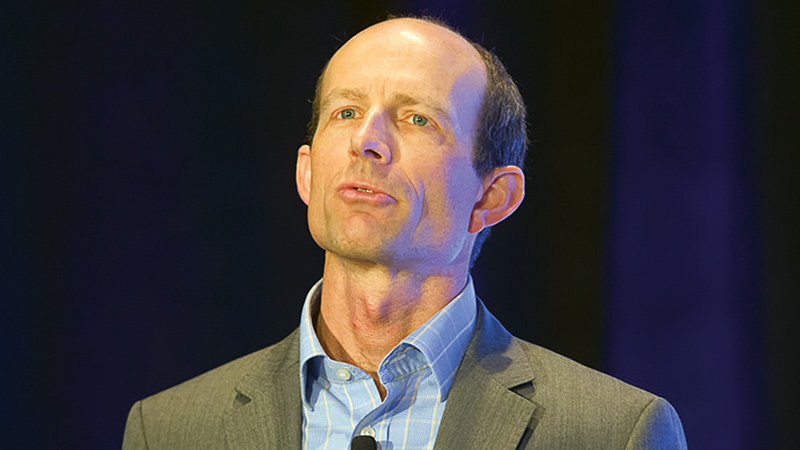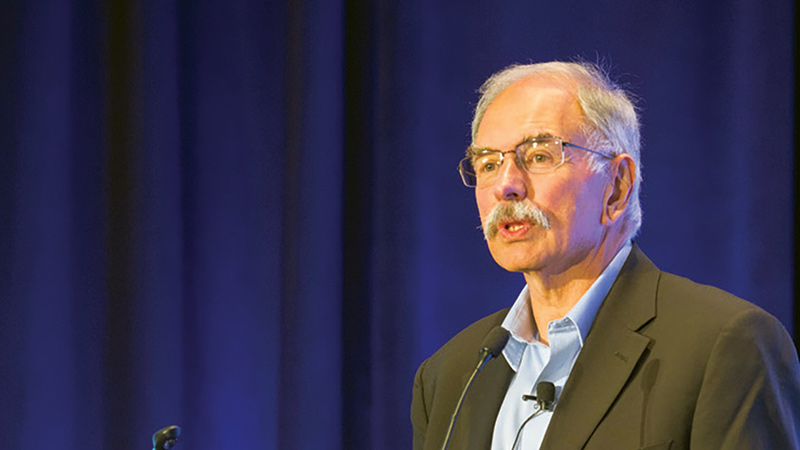Stay Up to Date
Submit your email address to receive the latest industry and Aerospace America news.
Air traffic control for drones is coming
With the increased use of unmanned aircraft in the years ahead, an air traffic management system for drones will be a necessity, said John Cavolowsky, director of the Airspace Operations and Systems Program in NASA’s Aeronautics Research Directorate. Cavolowsky shared some of NASA’s work on unmanned aerial systems traffic management, or UTM, during “Solutions to UAS Air Traffic Management Challenges” at the Demand for Unmanned Symposium.
UTM development is “a lot like herding cats, except they are smart cats with their own business objectives and needs,” Cavolowsky said. A lot of what a UTM system would do, he said, is “enable their access to the airspace in ways that haven’t been done before and trying to do that safely so that they can execute their missions successfully.”
According to Cavolowsky, a UTM system would be for drones that weigh 55 pounds or less and operate under 400 feet.
“It would be independent of the traditional air traffic management system that exists today,” he said, explaining that there “would be multiple UTM systems operating, not a single, large one,” which would allow users to tailor the systems to their needs.
Live from NASA’s Ames Research Center, NASA’s UTM development team showed real-time data from ongoing UTM tests in Virginia, North Dakota, Texas, Alaska and Nevada. They walked attendees through a variety of tests and the findings they have deduced so far from the data. The team said to achieve the tests, it worked with over 250 partners throughout the industry that plan to use drones in their businesses.
Cavolowsky reassured the audience that UTM will not supplant the need for humans in the loop.
“The thought that we will move people from the process anytime soon is not going to happen soon.”
— DUANE HYLAND | [email protected]
Changing culture with electric aviation
Electric-powered flight could improve safety, fuel efficiency and convenience, but innovators first have to clear regulatory hurdles and make the technology be accepted as part of daily life, a panel of aviation executives and officials said during the “Aircraft Electric Propulsion: Transforming Aviation” session.
Automakers are leading the way in electric and hybrid electric transportation, but aviation firms have yet to win over consumers and regulators who have “grandfathered in” gasoline as the accepted aircraft fuel, said Joseph Oldham, director of the San Joaquin Valley Clean Transportation Center for CALSTART. The nonprofit Oldham works for is dedicated to the growth of clean transportation technologies.
Switching to electric-powered flight would reduce carbon emissions and save on the fluctuating cost of gasoline, but Oldham said it would also make aircraft safer by removing the risk that aviation gas would explode in a malfunction or crash.
Electric flight could also help lower costs for regional airports and consumers who travel through them, said Matt Knapp, a founder of Zunum Aero. The startup, based in Kirkland, Washington, aims to create a hybrid jet with 10 to 50 seats designed to fly on low-cost trips shorter than 1,000 miles. Zunum’s planes would be powered by both jet fuel and electricity and would be designed to be upgraded with “evolving energy storage capacities” as battery technology improves. “Fuel is a highly volatile price point, and there is a cost to volatility,” Knapp said of the benefit of relying less on gasoline.
Fuel efficiency and safety are particularly important to advance vertical takeoff aircraft because hovering requires a stable and low-cost power source, Knapp said.
— TOM RISEN | [email protected]
Internet of things could enable drones
The “internet of things” will revolutionize the aviation industry, particularly through its application to the growing unmanned flight sector, a panel of experts said during the “Internet of Things as Applied to Aircraft Systems” session.
The internet of things is the networking of devices, vehicles, buildings, and other items with electronics, software, sensors, actuators and network connectivity. The connected objects are able to collect and exchange data, which offers aerospace manufacturers a way to have real-time data communications with their deployed products.
David Loda, executive director of Connecticut-based NCPS Research LLC, said that humans traditionally have had to manually harvest and collect data and then bring it back for design, but the internet of things is providing an autonomous capability. Leveraging the lessons already learned through the application of the internet of things, Loda said that the industry is now at a “major shift point when it comes to industrial drones.”
“Drones are going to change the world from the commercial side,” Loda said, explaining that drones will create a “data explosion” through what they are looking at. “It’s all about visualization and also about algebraic computation of how we can use new ways to visualize, and understand and mine this data.”
David Kasik, senior technical fellow in visualization and interactive techniques at Boeing, cautioned against abandoning data.
“Ultimately, what we want to do with all that data is not do something that I’ve termed to be write-only data stores, where you just store it and then nothing ever happens to it again,” he said. “You want to extract some value from it.” Kasik said the value drones provide “is that now we add visual cues that supplement those digital ones that have been around for literally decades.”
— LAWRENCE GARRETT | [email protected]
Avoiding city traffic with aerospace
A new wave of aerospace entrepreneurs and technology startups is stepping in to try to solve the problem of traffic, and according to a panel of experts, it could be done with vertical takeoff and landing, or VTOL, aircraft.
As any commuter knows, roadway congestion eats up a huge amount of time and energy, and “traffic is taking over our lives,” said Jon Rimanelli, founder and CEO of Airspace Experience Technologies.
He cited figures showing that every driver loses about $1,400 in fuel costs and productivity each year due to traffic.
“Key to this future is leveraging the automotive industrial base,” he said, adding that his company works with Uber, which has disrupted the taxi and car markets with its ridesharing app.
“Our mission is to support Uber, and their mission is to move people,” Rimanelli said.
Mark Moore, engineering director of aviation at Uber, said his company’s working on making electric VTOL a reality and plans to test the system as soon as 2020.
But, Moore insisted, “We see many participants in this system.”
One such example is Pipistrel, whose director of research and development, Tine Tomažič, explained where electric flight is in terms of development today.
“We understand what happens when you are really challenged with power demands,” Tomažič said.
However, he said, some of the problems that still need to be solved before eVTOL is a reality on a mass scale aren’t directly related to the vehicles themselves.
“When these vehicles are connected all the time to the service network, one has to think, ‘how do you isolate the vehicles from cyberattacks?’” Tomažič said.
— HANNAH THORESON | [email protected]
AIAA Aviation 2017
- 2,850 attendees
- 44 countries represented
- 650 students
Related Posts
Stay Up to Date
Submit your email address to receive the latest industry and Aerospace America news.






